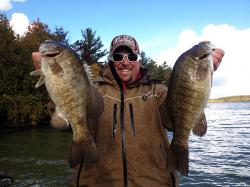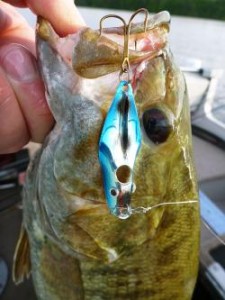Don’t Miss the Skinny Wasteland for Autumn Smallies
Super shallow and non-structured bottoms entice smallmouth so you can Catch Cold Water Smallmouth bass there
By Mitch Eeaganfrom The Fishing Wire
Cool days and even colder nights have water temperatures tumbling; bug hatches are coming to a halt. The once warm summer rains are turning bitter, too – crawlers and the like burrowing deep rather than getting washed into the drink. Young-of-the-year fishes that have avoided being eaten since birth have learned to be on the lookout for predators better than ever.
Captain Chris Noffsinger sporting smallmouth bling, which were caught from super-shallow water during the fall season.
To say the food sources of smallmouth bass dwindle as autumn arrives is an understatement.
As fall starts showing its face, a smallie’s diet turns to the only forage left: baitfish and crayfish; with the latter becoming scarcer as the season wanes. It’s this forage-vanishing-act that has bronze-finned prowlers on the move. It’s also what makes them easier to catch this time of year.
But smallmouths aren’t always roaming where you might think. Classic deep water haunts, weedbeds, reefs and sunken timber aren’t providing sustenance. So where might one find smallies when the leaves start turning? In depths registering only in the single digits; that’s 2 to 5 feet, even in ultra-clear water.
Wide Open Spaces
Enter Captain Chris Noffsinger, bass aficionado and fulltime guide on the waterways surrounding Traverse City, Michigan. Smallmouths have populated the Great Lakes and natural inland lakes here since the last glacier receded nearly 10,000 years ago. The fishery is loaded with trophy-size bass; many which are caught in places the average angler wouldn’t even consider casting.
“Sometimes my clients get a dumbfounded look on their faces when I tell them where to cast,” said Noffsinger. “But I don’t blame them, because, after all, we’re on giant sand flats with not a stitch of cover to be found except maybe some gravel or sand grass.
“The key to finding fish here lies in finding minnows,” adds Noffsinger. “You’ll see them near shore through your polarized glasses. And if you look closely, you’ll see smallies there, too.”
Cover and Cast
With trolling motor deployed, Noffsinger covers as much water as possible. Overall, the trick is using lures that imitate minnows, but at the same time, won’t dive into the dirt – spinnerbaits being a prime example. The captain’s favorite is Red Dirt Bait Company’s 1/2- and 3/4-ouncers, with painted willow-leaf blades, because they can be cast far, fished fast and his clients can cover a lot of water.
Spoons can be worked slowly, all the while staying in the strike zone without dredging bottom. Spoons, however, are rarely thought of as a smallmouth bait, yet do catch fish, and deserve more respect.
Lures that don’t dive into the dirt, like spinnerbaits and the Fin-Wing (pictured) imitate the minnows smallmouth chase in autumn.The #-3 Fin-Wing can be retrieved at a steady pace in super-shallow water without snagging up. It’s stamped from metal, but its wide, swimming wobble is nothing like that of an ordinary spoon. Because of the Fin-Wing’s unique shape, light reflects off it at multiple angles and the lure gets noticed like the flashing blades of a spinnerbait. Increase the speed of your retrieve and the Fin-Wing turns toward the sun and creates a wake, even rides the surface with a walk-the-dog action; perfect for first light in the shallows.
Soft Side
Noffsinger and his guests also throw soft-bodied lures like un-weighted flukes, aka soft jerkbaits. When retrieved with a twitch, these lures dart side to side wildly like an injured minnow.
If the smallies aren’t responding to the erratic motion of flukes, large grubs on a light-weight jig head, fished with a steady retrieve will often do the trick. BFishN’s 5-inch K Grub on a H20 Precision Jig is a great option as the grub’s mega tail has more than enough whirl to emit vibrations.
Stick it to ‘Em
Making long casts is a must in such clear, shallow water. Seven foot plus rods will get your bait farther from the boat. But fishin’ sticks must also have enough backbone to make a solid hookset, which can be challenging with so much line out.
Seventeen-pound-test fluorocarbon coursing through a St. Croix 7-foot Mojo Bass Spinnerbait casting rod, for example, will whip a spinnerbait a country mile and still stick a hook. The low stretch of fluoro helps oversized hooks penetrate a bass’ boney jaw, making the line perfect for spoons and spinnerbaits. Meanwhile, a 7-foot medium-power fast-action St. Croix Avid X, for instance, has the ability to properly launch a lighter soft plastic on 8-pound-test fluoro.
Going Nowhere Fast
If you’re looking to catch big smallies this fall, explore the shallow wastelands.
Position your boat on a shallow flat, cast shoreward and cover water with baitfish imitating lures. Make long casts and employ a rod and line that support solid hooksets at long distances.
You know all those featureless shallow flats you buzzed by all summer long? Time to put on the brakes and commence casting.

